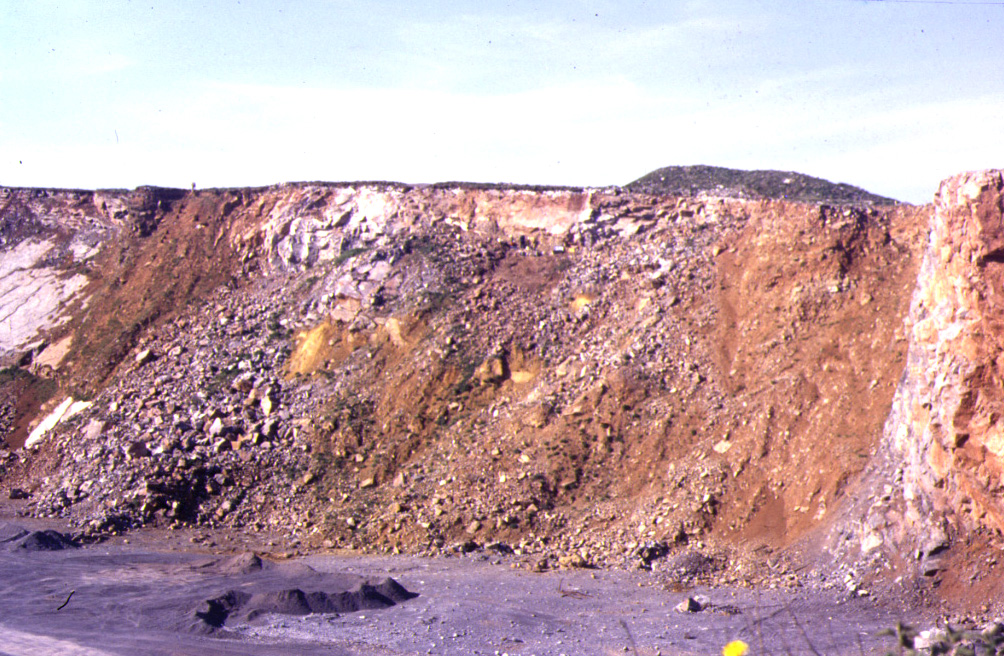|
|
Westbury-sub-Mendip
Somerset
|
|
|
|
|
|
|
|
Site Number 50
Nearest Town: Westbury-sub-Mendip
National Grid Reference: ST5080450387
Lat: 51.25051 Lon: -2.70626

In 1969 blasting at Westbury Quarry on the southern flank of the Mendip Hills, exposed a massive cave filled with well-preserved faunal remains. The site has been the object of intensive systematic examination and excavation, first by Michael Bishop, then of the University of Bristol, from 1972 to 1974, and subsequently by the Natural History Museum. Westbury constitutes the first cave fauna of its age in Britain. It fills a major gap in the British Middle Pleistocene faunal succession and probably belongs to a single but climatically variable interglacial that succeeded the type Cromerian.
Two major lithostratigraphical units are represented in the cave fill, the Siliceous Member, a complex of waterlain silts, sands and gravels with a comparatively sparse derived fauna, which is overlain by the Calcareous Member, a finely stratified sequence of cave earths and breccias, rich in vertebrate remains, principally those of mammalian carnivores and small mammals. At present a little over 55 mammalian species are represented in the collections from Calcareous Member, as well as numerous birds, reptiles, amphibians and fish. Changes in the vertebrate fauna and episodes of speleothem formation show that the environment fluctuated between cold conditions with tundra or boreal forest and fully temperate episodes supporting deciduous woodland. The sequence records at least two temperate phases (units 11-12 and unit 15) separated by a cool interval (units 13-14) and a further period of cold-cool conditions at the top of the sequence (top of unit 15 and in the Main Chamber units 18-19). There may also be an early warm phase (unit 8) followed by a cool phase (units 9-10).
Claims for stone tools remain controversial, but a single cut-marked bone from unit 19 provides compelling evidence for a human presence.
Mammal remains from the Siliceous Member (‘Westbury 1’ of Bishop 1982) comprise a variety of derived material, much of it fragmentary and heavily rolled, and possibly heterogeneous in both source and age. The fauna includes hyaena, rhinoceros and a bovid; micromammals are much rarer, but include the only British record of the vole Microtus (Allophaiomys).
|
Horizons recorded at Westbury-sub-Mendip
|
Unit Name
|
Epoch
|
Biozone
|
MIS
|
|
Main Chamber, Unit 20 (Horz Num: 649)
|
Middle Pleistocene
|
'Cromerian'
|
15?
|
|
Main Chamber, Unit 19/4 (Horz Num: 650)
|
Middle Pleistocene
|
'Cromerian'
|
15?
|
|
Main Chamber, Unit 19 (Horz Num: 651)
|
Middle Pleistocene
|
'Cromerian'
|
15?
|
|
Main Chamber, Unit 18 (Horz Num: 652)
|
Middle Pleistocene
|
'Cromerian'
|
15?
|
|
Side Chamber, Unit 15/8 (Horz Num: 653)
|
Middle Pleistocene
|
'Cromerian'
|
15?
|
|
Side Chamber, Unit 15/5 (Horz Num: 654)
|
Middle Pleistocene
|
'Cromerian'
|
15?
|
|
Side Chamber, Unit 15/2 (Horz Num: 655)
|
Middle Pleistocene
|
'Cromerian'
|
15?
|
|
Side Chamber, Unit 15/1 (Horz Num: 656)
|
Middle Pleistocene
|
'Cromerian'
|
15?
|
|
Side Chamber, Unit 14 (Horz Num: 657)
|
Middle Pleistocene
|
'Cromerian'
|
15?
|
|
Side Chamber, Unit 13 (Horz Num: 658)
|
Middle Pleistocene
|
'Cromerian'
|
15?
|
|
Side Chamber, Unit 12 (Horz Num: 659)
|
Middle Pleistocene
|
'Cromerian'
|
15?
|
|
Yellow silty breccia, pink breccia, and dark brown breccia (Horz Num: 50)
|
Middle Pleistocene
|
'Cromerian'
|
15?
|
|
Side Chamber, Unit 11/4 (Horz Num: 245)
|
Middle Pleistocene
|
'Cromerian'
|
15?
|
|
Side Chamber, Unit 8 (Horz Num: 246)
|
Middle Pleistocene
|
'Cromerian'
|
15?
|
|
Calcareous member (Horz Num: 247)
|
Middle Pleistocene
|
'Cromerian'
|
15?
|
|
Siliceous Layer (Horz Num: 248)
|
Early Pleistocene
|
Undefined
|
?
|
|
|

